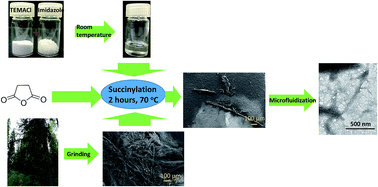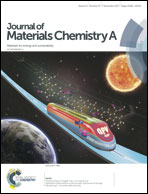Anionic wood nanofibers produced from unbleached mechanical pulp by highly efficient chemical modification†
Abstract
Chemical modification of lignocellulosic materials, especially as a pre-treatment in nanocellulose production, has mainly been conducted with lignin-free bleached cellulose pulps. However, non-bleached pulp exhibits several advantages over bleached pulp, namely excluding of the use of hazardous bleaching chemicals, higher yield, and lower cost. In this study, the chemical modification of lignocellulose (groundwood pulp, GWP) with a high lignin content (27.4 wt%) was investigated using a deep eutectic solvent (DES) as a reaction medium. A low-melting DES was easily obtained within one hour by mixing triethylmethylammonium chloride (TEMACl) and imidazole at room temperature. Carboxylated GWP was obtained by adding succinic anhydride to the DES. Under mild reaction conditions (2 h at 70 °C), carboxylic acid contents of 1.88–3.34 mmol g−1 were obtained depending on the anhydride dosage used (5–20 mmol/1 g of pulp) with excellent yield (over 90%). The GWP was more reactive in the pre-treatment step, measuring carboxylic acid contents higher than those of bleached cellulose pulps treated under identical reaction conditions (containing less than 0.5 wt% lignin). After deprotonation of the carboxylic acid groups, highly anionic wood nanofibers (AWNFs) were produced using a microfluidizer. Vacuum filtration was applied in the preparation of self-standing films, which had good mechanical properties and were transparent. The fabricated AWNFs have many potential uses—for instance, in sustainable water purification because of their adjustable surface charge.



 Please wait while we load your content...
Please wait while we load your content...